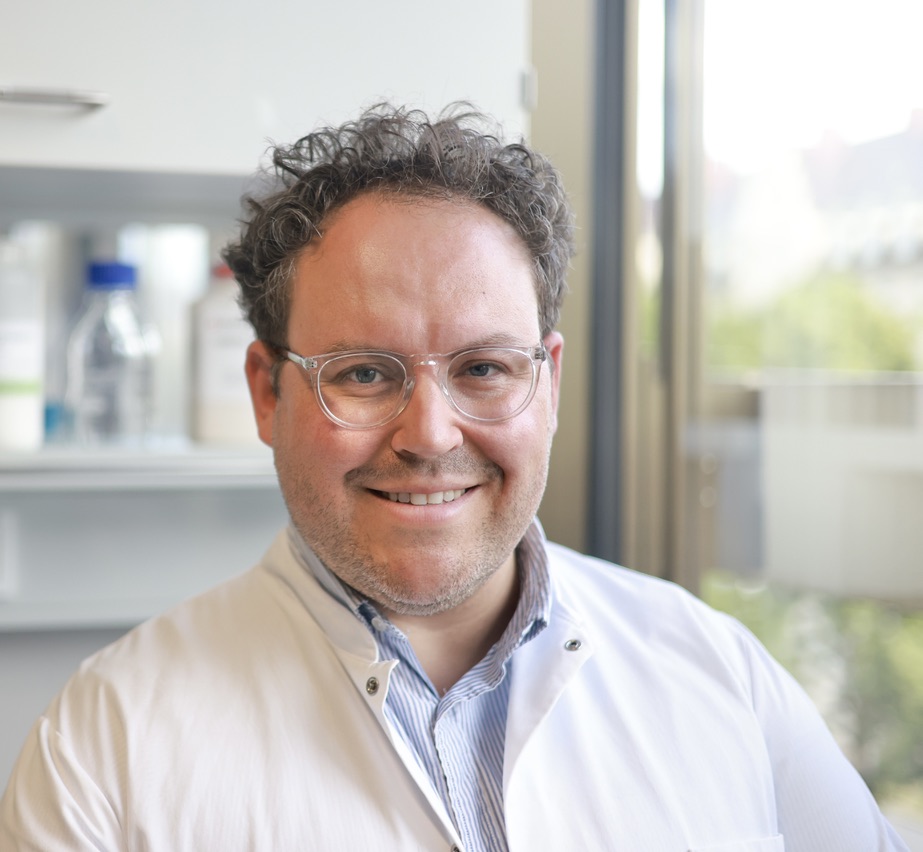Team
Cardiovascular Research

Selected publications:
Görlach A, Lee P, Roesler J, Hopkins PJ, Christensen B, Green ED, Chanock SJ, Curnutte JT: "A p47-phox pseudogene carries the most common mutation causing p47-phox- deficient chronic granulomatous disease". J Clin Invest. 1997;100(8): 1907
Görlach A, Brandes RP, Nguyen K, Amidi M, Busse R: "A gp91phox containing NADPH oxidase selectively expressed in endothelial cells is a major source of oxygen radical generation in the arterial wall". Circ Res. 2000; 87 (1): 26-32.
Görlach A, Diebold I, Schini-Kerth VB, Berchner-Pfannschmidt U, Roth U, Brandes RP, Kietzmann T, Busse R: "Thrombin activates the HIF-1 signaling pathway in vascular smooth muscle cells. Role of the p22phox-containing NADPH oxidase".
Circ Res. 2001; 89(1):47-54.
BelAiba RS, Djordjevic T, Bonello S, Lang F, Hess J, Görlach A: "The serum- and glucocorticoid-regulated kinase Sgk-1 promotes redox-sensitive upregulation of tissue factor by thrombin". Circ Res. 2006; 98 (6): 828-836.
Diebold I, Djordjevic T, Petry A, Hatzelmann A, Tenor H, Hess J, Görlach A: "Phosphodiesterase 2 Mediates Redox-Sensitive Endothelial Cell Proliferation and Angiogenesis by Thrombin via Rac1 and NADPH Oxidase 2".
Circ Res. 2009; 104(10):1169-77.
https://www.dhm.mhn.de/de/kliniken_und_institute/klinik_fuer_angeborene_herzfeh/forschung/experimentelle_und_molekulare_.cfm

Interventional cardiology; Clinical trials, incl. quantitative coronary angiography, optical coherence tomography; Genetic analysis; Prognostic biomarker analysis:
- Stent thrombosis
- Stent restenosis
- Improvement of stent technology, development and testing of drug-eluting stents
- periinterventional pharmacotherapy
- clinical relevance of platelet function tests
- Treatment strategies of acute coronary syndromes
- influence of genetic factors on outcome after PCI
- systematic review of randomized trials
Selected publications:
Schomig A, Neumann FJ, Kastrati A, Schuhlen H, Blasini R, Hadamitzky M, Walter H, Zitzmann-Roth EM, Richardt G, Alt E, Schmitt C, Ulm K. A randomized comparison of antiplatelet and anticoagulant therapy after the placement of coronary-artery stents. N Engl J Med 1996; 334(17):1084-1089.
Schomig A, Kastrati A, Dirschinger J, Mehilli J, Schricke U, Pache J, Martinoff S, Neumann FJ, Schwaiger M. Coronary stenting plus platelet glycoprotein IIb/IIIa blockade compared with tissue plasminogen activator in acute myocardial infarction. Stent versus Thrombolysis for Occluded Coronary Arteries in Patients with Acute Myocardial Infarction Study Investigators. N Engl J Med 2000; 343(6):385-391.
Kastrati A, Mehilli J, Schuhlen H, Dirschinger J, Dotzer F, ten Berg JM, Neumann FJ, Bollwein H, Volmer C, Gawaz M, Berger PB, Schomig A. A clinical trial of abciximab in elective percutaneous coronary intervention after pretreatment with clopidogrel. N Engl J Med 2004; 350(3):232-238.
Dibra A, Kastrati A, Mehilli J, Pache J, Schuhlen H, von Beckerath N, Ulm K, Wessely R, Dirschinger J, Schomig A. Paclitaxel-eluting or sirolimus-eluting stents to prevent restenosis in diabetic patients. N Engl J Med 2005; 353(7):663-670.
Kastrati A, Mehilli J, Pache J, Kaiser C, Valgimigli M, Kelbaek H, Menichelli M, Sabate M, Suttorp MJ, Baumgart D, Seyfarth M, Pfisterer ME, Schomig A. Analysis of 14 trials comparing sirolimus-eluting stents with bare-metal stents. N Engl J Med 2007; 356(10):1030-1039.
Kastrati A, Neumann FJ, Mehilli J, Byrne RA, Iijima R, Buttner HJ, Khattab AA, Schulz S, Blankenship JC, Pache J, Minners J, Seyfarth M, Graf I, Skelding KA, Dirschinger J, Richardt G, Berger PB, Schomig A. Bivalirudin versus unfractionated heparin during percutaneous coronary intervention. N Engl J Med 2008; 359(7):688-696.
Kastrati A, Ndrepepa G. Cangrelor -- a champion lost in translation? N Engl J Med 2009; 361(24):2382-2384.
https://www.dhm.mhn.de/en/home.cfm

An urgent need in cardiovascular medicine is to develop novel therapeutic tools and approaches to restore proper function of diseased hearts and to regenerate cardiac muscle after injury. Regenerative therapies, either by transplantation of stem cells or stem cell-derived differentiated cells into the defective organ or by promoting endogenous regenerative processes, are an important goal of cardiovascular research. In order to translate successfully these concepts into patient care, several fundamental research questions have to be answered. One core activity of this group is to address such questions with state-of-the-art methods. Among others, these techniuqes are applicated: generation, culture and differentiation of human pluripotent stem cells; genetic modification (CRISPR/Cas System); optical physiological characterization of cardiomyocytes (Calcium imaging, membrane potential imaging, second messenger imaging); 3D culture of iPS-derived cardiomyocytes; gene expression analysis (RNAseq, single-cell RNAseq); molecular cloning and cell injection into murine embryos.
Molecular Medicine

Our group is exploring how different immune cell signals contribute to the development of different B cell malignancies and how metabolic cues support the escape of B cell intrinsic checkpoint that usually prevent transformation. The current focuses of our laboratory are on the transformation of chronic lymphocytic leukemia to an aggressive lymphoma as well as the plasma cell disorder multiple myeloma. Mouse models recapitulating major mechanisms of the human diseases play an important role in our work. Using transgenic mouse lines with the Cre-loxP technology, we investigate the influence of several (signalling) factors on the development and the progression of diseases in these animal models.
CLL and Richter’s Transformation:
We have established a model to mimic the transformation of CLL to an aggressive lymphoma by additional oncogene activation. We have observed that acute oncogene activation in CLL cells induces cell death in the vast majority of CLL cells (Ecker et al, Nat. Comm. 2021). However, some cells survive and then outgrow the initial tumor and show several features of Richter cells. We now aim to use this model to understand which mechanism support the survival of the cells giving rise to the aggressive lymphoma and verify these in human samples. Understanding those mechanisms may help to prevent or treat the aggressive Richter lymphoma, which has a very poor clinical outcome.
CLL and drug resistance:
Another focus of our group is to understand how different signals from the microenvironment support the expansion of CLL cells despite the highly effective treatment with the BTK inhibitor ibrutinib or the BCL2 inhibitor venetoclax. We investigate strategies to prevent these interactions and to breach the strong immunosuppressive character of CLL cells, which then are tested in combination with immunotherapy (CAR T cells and checkpoint inhibition) in CLL.
Multiple Myeloma:
We have generated a novel mouse model that reflects the human plasma cell disorder multiple myeloma in several ways. To gain insight into the pathogenesis of this deadly disease, we aim to analyse which factors contribute to the disease evolution in our model and compare it with data of human myeloma samples.
- no information -

Our Emmy Noether group is focused on engineering CRISPR technologies for research and therapeutic applications in cardiovascular medicine. We also aim to apply the newest gene editing tools in stem cells, ex vivo tissues, and organoids. The lab is located at the TranslaTUM Organoid Hub of the Center for Organoid Systems (COS). Please reach out to Julian, if you’re interested in learning more!
Lab website: http://grunewaldlab.org
Twitter: @grunewaju
Selected Publications:
Hsu, J.Y., Grünewald, J., Szalay, R., Shih, J., Anzalone, A.V., Lam, K.C., Shen, M.W., Petri, K., Liu, D.R., Joung, J.K., Pinello L. - PrimeDesign software for rapid and simplified design of prime editing guide RNAs. Nature Communications 12, 1034 (2021)
Kurt, I. C., Zhou, R., Iyer, S., Garcia, S. P., Miller, B. R., Langner, L. M., Grünewald, J.,* & Joung, J. K.* - CRISPR C-to-G base editors for inducing targeted DNA transversions in human cells. Nature Biotechnology 39(1), 41-46 (2021) *co-corresponding author
Grünewald, J.*, Zhou, R.*, Lareau, C. A., Garcia, S. P., Iyer, S., Aryee, M. J., & Joung, J. K. - A Dual-Deaminase CRISPR Base Editor Enables Concurrent Adenine and Cytosine Editing. Nature Biotechnology. 38(7), 861-864 (2020) *co-first author
Grünewald, J., Zhou, R., Iyer, S., Lareau, C. A., Garcia, S. P., Aryee, M. J., & Joung, J. K. - CRISPR DNA base editors with reduced RNA off-target and self-editing activities. Nature Biotechnology, 37(9), 1041–1048 (2019)
Grünewald, J., Zhou, R., Garcia, S. P., Iyer, S., Lareau, C. A., Aryee, M. J., & Joung, J. K. Transcriptome-wide off-target RNA editing induced by CRISPR-guided DNA base editors. Nature, 569(7756), 433–437 (2019)
For more comprehensive & updated publications, please check:
https://scholar.google.com/citations?user=Qf1ikKUAAAAJ&hl=en&oi=ao

The endosomal system plays an essential role in maintaining cell homeostasis by controlling cellular signaling, nutrient sensing, cell polarity and cell migration. However, its place in the regulation of tissue, organ and whole body physiology and metabolism is less well understood. Therefore, the Zeigerer group investigates the novel link between endocytosis and metabolism with impact on metabolic disease such as type-2 diabetes and fatty liver disease. In particular, we are interested in how components of the endo-lysosomal system influence glucose and lipid metabolism in the liver. On the other hand, we investigate how metabolic cues, such as the fasting/feeding transition and metabolic abnormalities alter endo-lysosomal function. To address these research areas, the lab uses primary mouse and human hepatocyte 3D cultures, where hepatocytes regain cell polarity and liver-specific metabolic functions, as well as in vivo liver specific nanoparticle mediated knockdown technology, coupled with biochemistry, cellular metabolic assays, high-resolution confocal microscopy and quantitative imaging. This approach enables to bridge two so far unconnected research areas, intracellular trafficking and metabolism, leading to the establishment of a new research direction and a simultaneous development of a new class of therapeutic target structures for metabolic diseases.
Publications: https://pubmed.ncbi.nlm.nih.gov/?term=Zeigerer+A
- no information -
Oncology

The pediatric oncology research group focuses on the following two topics of (1) genetic predisposition in childhood cancer and prevention of acute leukemias and (2) translational cellular immunotherapy and oncolytic virotherapy against pediatric sarcoma.
(1) Acute leukemias: Not long ago, genetic predisposition to childhood cancer was purely believed to be attributed to “chance” or “bad-luck”. Now it has been proven that de-novo or inherited cancer predispositions can cause up to 15% of all pediatric tumors. Nevertheless, the overall impact of genetic predispositions is believed to be much higher, with most yet to be discovered. In this regard, we aim to identify and characterize novel disease-causing germline mutations in children with cancer. We further investigate the interplay of genetic predisposition and environmental challenges, including infection and early immune training, in transgenic murine models. By understanding the underlying genetic basis of cancer in combination with training of the innate and adaptive immune system we subsequently aim for early preventive strategies against childhood leukemia.
(2) Pediatric Sarcoma: Pediatric patients with advanced sarcoma carry a poor prognosis, which is why innovative therapy options for these patients are urgently needed. The success of immunotherapy in the treatment of patients with solid tumours is predominantly restricted to entities showing high numbers of tumour infiltrating T cells e.g. directed against somatic mutation derived neo-antigens such as in malignant melanoma. However, unlike melanoma, pediatric cancers such as Ewing’s sarcoma (EwS) are predominantly less immunogenic, probably due to low somatic mutation rates. As therapeutic options for these patients have reached a plateau, innovative new treatment options are warranted. In this regard, our research goal is the introduction of innovative therapy designs such as T cell based immunotherapeutic approaches to improve survival of children and adolecents with high-risk pediatric sarcoma.
Selected publications
(1)
Escudero, A., Takagi, M., Auer, F., Friedrich, U. A., Miyamoto, S., Ogawa, A., Imai, K., Pascual, B., Vela, M., Stepensky, P., Yasin, L., Elitzur, S., Borkhardt, A., Pérez-Martínez, A., & Hauer, J. (2022). Clinical and immunophenotypic characteristics of familial leukemia predisposition caused by PAX5 germline variants. Leukemia, 36(9), 2338–2342.
Schedel A, Friedrich UA, Morcos MNF, et al. Recurrent Germline Variant in RAD21 Predisposes Children to Lymphoblastic Leukemia or Lymphoma. Int J Mol Sci. 2022;23(9):5174.
Hauer J, Fischer U, Borkhardt A. Toward prevention of childhood ALL by early-life immune training. Blood. 2021;138(16):1412-1428.
Bhatia, S., Diedrich, D., Frieg, B., Ahlert, H., Stein, S., Bopp, B., Lang, F., Zang, T., Kröger, T., Ernst, T., Kögler, G., Krieg, A., Lüdeke, S., Kunkel, H., Rodrigues Moita, A. J., Kassack, M. U., Marquardt, V., Opitz, F. V., Oldenburg, M., Remke, M., … Hauer, J. (2018). Targeting HSP90 dimerization via the C terminus is effective in imatinib-resistant CML and lacks the heat shock response. Blood, 132(3), 307–320.
Martín-Lorenzo A, Hauer J, Vicente-Dueñas C, et al. Infection Exposure is a Causal Factor in B-cell Precursor Acute Lymphoblastic Leukemia as a Result of Pax5-Inherited Susceptibility. Cancer Discov. 2015;5(12):1328-1343.
(2)
Biele E, Schober SJ, Prexler C, et al. Monocyte Maturation Mediators Upregulate CD83, ICAM-1 and MHC Class 1 Expression on Ewing's Sarcoma, Enhancing T Cell Cytotoxicity. Cells. 2021;10(11):3070.
Thiel U, Schober SJ, Ranft A, et al. No difference in survival after HLA mismatched versus HLA matched allogeneic stem cell transplantation in Ewing sarcoma patients with advanced disease. Bone Marrow Transplant. 2021;56(7):1550-1557.
Schober SJ, Thiede M, Gassmann H, et al. MHC Class I-Restricted TCR-Transgenic CD4+ T Cells Against STEAP1 Mediate Local Tumor Control of Ewing Sarcoma In Vivo. Cells. 2020;9(7):1581.
Thiel U, Schober SJ, Einspieler I, et al. Ewing sarcoma partial regression without GvHD by chondromodulin-I/HLA-A*02:01-specific allorestricted T cell receptor transgenic T cells. Oncoimmunology. 2017;6(5):e1312239.
Kirschner A, Thiede M, Grünewald TG, et al. Pappalysin-1 T cell receptor transgenic allo-restricted T cells kill Ewing sarcoma in vitro and in vivo. Oncoimmunology. 2017;6(2):e1273301.
- no information -
Neuroscience

The Portugues lab studies how the brain generates behavior. This requires understanding what features of the environment are behaviorally relevant, how the brain is tuned to respond to them, what mechanisms are in place to select appropriate actions and how learning can lead to improved interactions between the animal and its environment. We mainly use the larval zebrafish, a small vertebrate, as a model organism.
We use a highly multidisciplinary approach that uses behavior, functional calcium imaging (both 2-photon and light-sheet microscopy), optogenetics, electrophysiology, computational and theoretical methods to dissect these questions across scales that range from a single neuron to the 100,000 neurons that comprise the whole brain of zebrafish larvae.
Selected publications:
Markov DA, Petrucco L, Kist AM, Portugues, R (2021). “A cerebellar internal model calibrates a feedback controller involved in sensorimotor control.” Nature Communications, in press.
Yildizoglu T, Riegler C, Fitzgerald JE*, Portugues R* (2020). “A Neural Representation of Naturalistic Motion-Guided Behavior in the Zebrafish Brain.” Current Biology 30 (12), 2321-2333.
Dragomir EI, Štih V, Portugues R (2020). “Evidence accumulation during a sensorimotor decision task revealed by whole-brain imaging”. Nature Neuroscience. 2020; (23) 85-93.
Kist AM, Portugues R (2019). “Optomotor swimming in larval zebrafish is sriven by global whole-field visual motion and local light-dark transitions.” Cell Reports, 29 (3), 659-670.
Štih V*, Petrucco L*, Kist AM, Portugues R (2019). “Stytra: An open-source, integrated system for stimulation, tracking and closed-loop behavioral experiments”. PLOS Computational Biology, 15 (4), e1006699.
Knogler LD, Kist AM, Portugues R (2019). "Motor context dominates output from purkinje cell functional regions during reflexive visuomotor behaviours". eLife. 2019: e42138.
Knogler LD, Markov AD, Dragomir EI, Štih V, Portugues R (2017). "Sensorimotor representations in cerebellar granule cells in larval zebrafish are dense, spatially organized, and non-temporally patterned". Current Biology. 2017; 27(9): 1288-1302.
Oteiza P, Odstrcil I, Lauder G, Portugues R, Engert F(2017). "A novel mechanism for mechanosensory-based rheotaxis in larval zebrafish". Nature. 2017: 547(7664): 445-448.
Portugues R, Feierstein CE, Engert F, Orger MB (2014). "Whole-brain activity maps reveal stereotyped, distributed networks for visuomotor behavior". Neuron. 2014; 81(6): 1328-1343.
Severi KE*, Portugues R*#, Marques JC, O'Malley DM, Orger MB, Engert F# (2014). “Neural control and modulation of swimming speed in the larval zebrafish.” Neuron 83 (3), 692-707.
Ahrens MB, Li JM, Orger MB, Robson DN, Schier AF, Engert F, Portugues R (2012). Brain-wide neuronal dynamics during motor adaptation in zebrafish. Nature 485: 471-477.
- no information -

Research focus:
The brain consumes 20% of the human body’s energy budget. Neuronal communication among highly connected brain regions is the main driver of the brain’s energy demands. While we know much about the macroscopic organization of the human brain in specialized regions and brain networks, the energy budget of human brain function is still unclear. Moreover, brain metabolism is heavily disturbed in several neuropsychiatric disorders but the relationship to brain network communication is also unknown.
In my research group, we measure energy consumption of the human brain and relate these to common measures of brain organization. We simultaneously acquire energy metabolism and brain connectivity measures on an integrated PET/MR (Siemens Biograph mMR) scanner. We measure inhibitory and excitatory neurotransmitter levels using 1H-Magnetic Resonance Spectroscopy (MRS) and modulate brain function using non-invasive, stereotactic transcranial magnetic stimulation (TMS).
Methods: hybrid PET/MRI (Positron Emission Tomography, Magnetic Resonance Imaging), Magnetic Resonance Spectroscopy (MRS), Transcranial Magnetic Stimulation (TMS)
Research projects:
- Develop analytical or graph metrical approaches to integrate brain profiles of energy metabolism and network connectivity.
- Study the energy metabolism of brain networks during cognitive tasks.
- Link brain energetics with nutrition and body metabolism.
- Uncover deficient metabolic brain profiles in patients with neuropsychiatric disorders.
website:
- no information -

Studying prenatal human brain development remains a challenge due to limited access to live human brain tissue and ethical constraints on research using human embryos. Recent advances in stem cell biology have revolutionized the field of human developmental biology by allowing us to generate three-dimensional models that recapitulate structural organization of various organs, including the brain.
Our lab focuses on advancing novel stem cell-based technologies to generate three-dimensional models that recapitulate the structural and functional organization of the human brain. We leverage these technologies to push the boundaries for personalized research on human-specific brain disorders and to identify strategies for facilitating brain repair.
Selected Publications:
Schafer, S.T., Paquola, A.C.M., Stern, S., Gosselin, D., Ku, M., Pena, M., Kuret, T.J.M., Liyanage, M., Mansour, A.A., Jaeger, B.N., Marchetto, M.C., Glass, C.K., Mertens, J. & Gage, F.H. (2019) Pathological priming causes developmental gene network heterochronicity in autistic subject-derived neurons. Nature Neuroscience 22, 243
Herdy, J., Schafer, S.T., Kim, Y., Ansari, Z., Zangwill, D., Ku, M., Paquola, A., Lee, H., Mertens, J. & Gage, F.H. (2019) Chemical modulation of transcriptionally enriched signaling pathways to optimize the conversion of fibroblasts into neurons. eLife 8, e41356
Gonçalves, J.T.*, Schafer, S.T.* & Gage, F.H. (2016) Adult Neurogenesis in the Hippocampus: From Stem Cells to Behavior. Cell 167, 897–914 [equal contribution]
Han, J., Kim, H.J.*, Schafer, S.T. *, Paquola, A., Clemenson, G.D., Toda, T., Oh, J., Pankonin, A.R., Lee, B.S., Johnston, S.T., Sarkar, A., Denli, A.M. & Gage, F.H. (2016) Functional Implications of miR-19 in the Migration of Newborn Neurons in the Adult Brain. Neuron 91, 79–89 [equal contribution]
Schafer, S.T., Han, J., Pena, M., von Bohlen und Halbach, O., Peters, J. & Gage, F. H. (2015) The Wnt Adaptor Protein ATP6AP2 Regulates Multiple Stages of Adult Hippocampal Neurogenesis. J Neurosci 35, 4983–4998
Han, J., Kim, H.J.*, Schafer, S.T. *, Paquola, A., Clemenson, G.D., Toda, T., Oh, J., Pankonin, A.R., Lee, B.S., Johnston, S.T., Sarkar, A., Denli, A.M. & Gage, F.H. (2016) Functional Implications of miR-19 in the Migration of Newborn Neurons in the Adult Brain. Neuron 91, 79–89 [equal contribution]
Mertens, J., Wang, Q.W., Kim, Y., Yu, D.X., Pham, S., Yang, B., Zheng, Y., Diffenderfer, K. E., Zhang, J., Soltani, S., Eames, T., Schafer, S.T., Boyer, L., Marchetto, M.C., Nurnberger, J.I., Calabrese, J.R., Oedegaard, K.J., McCarthy, M.J., Zandi, P.P., Alda, M., Nievergelt, C.M., Mi, S., Brennand, K.J., Kelsoe, J.R., Gage, F.H. & Yao, J. (2015) Differential responses to lithium in hyperexcitable neurons from patients with bipolar disorder. Nature 527, 95–99
Contact:
Simon T. Schäfer, PhD
Assistant Professor for Advanced Organoid Technologies for Mental Health Research
Technical University of Munich (TUM)
School of Medicine
Department of Psychiatry and Psychotherapy
TranslaTUM, Center for Organoid Systems
Organoid Hub, Room 22.2.18
Einsteinstr. 25
81675 Munich, Germany
- no information -
